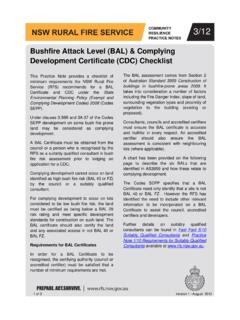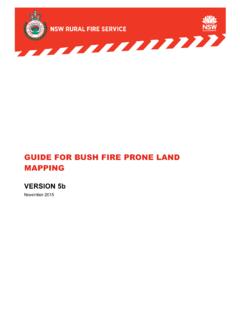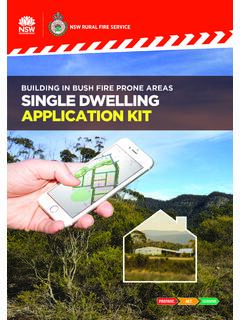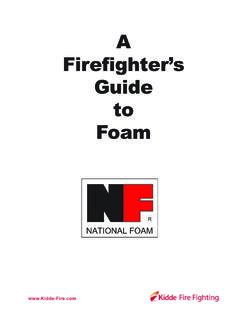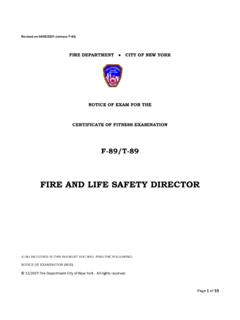Transcription of SERVICE STANDARD 5.1.9 RESPIRATORY PROTECTIVE …
1 SERVICE STANDARD RESPIRATORY PROTECTIVE equipment 28 JANUARY 2022 1 of 13 SERVICE STANDARD RESPIRATORY PROTECTIVE equipment ITEM DESCRIPTION Version Number SOPs SOP - 1 Disposable P2 Respirators SOP 2 Reusable Respirators SOP 3 Compressed Air Breathing Apparatus SOP 4 CABA Filling Stations Owner Deputy Commissioner Preparedness & Capability Contact Manager Engineering Approved Date 28 January 2022 Effective Date 28 January 2022 Next Review Date This STANDARD must be reviewed within 12 months of publication Document Control Electronic - Printed Copies are Uncontrolled 1 Purpose This SERVICE STANDARD ensures that members engaged with various NSW Rural Fire SERVICE (NSW RFS) operational activities are provided with RESPIRATORY PROTECTIVE equipment (RPE) appropriate to their role and tasks, which also satisfies the requirements of the Workplace Health and Safety Act (2011) and relevant Australian and/or International Standards as appropriate.
2 This SERVICE STANDARD and associated STANDARD Operating Procedures (SOPs) apply to operational environments within which NSW RFS members work. This SERVICE STANDARD and associated SOPs cover the proper acquisition, use, training and maintenance of RPE in the NSW RFS. This SERVICE STANDARD covers RPE as defined by AS/NZS 1715:2009, as well as all RPE support equipment , including but not limited to: a. P2 Respirators; b. Reusable Respirators; c. Compressed Air Breathing Apparatus (CABA); d. CABA support equipment ; e. CABA filling stations. SERVICE STANDARD RESPIRATORY PROTECTIVE equipment 28 JANUARY 2022 2 of 13 2 Definitions For the purpose of this SERVICE STANDARD , the following definitions and acronyms apply: a. Flame Resistant: a term used to describe a material that burns slowly or is self-extinguishing after removal of an external source of ignition. b. Incident Ground: refers to an area of operational activity, fire grounds, hazard reductions, motor vehicle accidents, structure fires, air bases, assist other agencies, automatic fire alarm, etc.
3 C. Immediate Danger to Life and Health (IDLH): Refers to hazards or hazardous environments in which an acute exposure to the hazard poses a severe risk of immediate health damage. Examples Include: i. TOES: Toxic atmospheres, Oxygen deficiency, Elevated temperatures and Smoke Refers to the identifying factors for high risk environments. ii. HOTS: Heated atmosphere, Oxygen deficiency, Toxic environments and Smoke. d. Personal PROTECTIVE equipment (PPE): refers to equipment designed to mitigate the risk of injury from physical, thermal and other hazards that may be encountered at an incident (including but not limited to, helmets, goggles, gloves, etc.). e. Personal PROTECTIVE Clothing (PPC): refers to PROTECTIVE clothing designed to mitigate the risk of injury from physical, thermal and other hazards that may be encountered at an incident (including but not limited to, jackets, trousers, etc.)
4 F. PPE/C: refers to the combination of personal PROTECTIVE equipment and personal PROTECTIVE clothing, which meets the NSW RFS specifications and that has been approved by the NSW RFS. g. RPE: refers to RESPIRATORY PROTECTIVE equipment and is alternately known as RESPIRATORY protection devices (RPD). RPE is PPE that is designed to protect the wearer from inhalation of airborne contaminants and other hazardous substances that is certified to AS/NZS 1715:2009. h. NSW RFS Approved RPE: RPE that has been assessed by the NSW RFS and is deemed to meet the NSW RFS technical specifications and relevant International/Australian standards. These RPE items are supported by the NSW RFS for purchasing, issuing and the provision of consumables. i. Contaminated RPE: Refers to respirators, canisters/filters and other RPE equipment that has been worn and not yet cleaned and returned to a serviceable condition, or cannot be returned to a serviceable condition.
5 J. Clean shaven: Where all facial hair of any length, including stubble, is removed where the respirator contacts and seals to ensure a proper fit. This does not include facial hair which does not interfere with the respirator seals. k. Fit Test: A documented procedure undertaken by a certified person, in accordance with Australian Standards, to determine the facial fit of a respirator. l. Quantitative Fit Test: A fail/pass facial fit test based on the capability to taste a known irritant, and suitable for RPE with a protection factor of 10 or less. m. Qualitative Fit test: A measured facial fit test utilising certified equipment to provide a facial fit score and suitable for all RPE types. n. Fit Check: A self-administrated rapid facial fit check, to ensure a proper seal is achieved by a respirator. Fit checks may either be positive or negative pressure, depending on the respirator type.
6 3 Policy RESPIRATORY PROTECTIVE equipment (RPE) is considered the last line of defence (as stated in the Bush Firefighter Manual) and should always be utilised in conjunction with other controls, such as safe work practices. Priority should always be given to removing members from areas of RESPIRATORY risk. Members are to apply the Hierarchy of Controls and be responsible for reducing their exposure to RESPIRATORY hazards. This includes limiting exposure time to a RESPIRATORY hazard where possible. Where it is not practical to remove members from an area that may expose them to a RESPIRATORY risk, then SERVICE STANDARD RESPIRATORY PROTECTIVE equipment 28 JANUARY 2022 3 of 13 RPE should be used to reduce that risk, in line with the relevant training material and Fire ground SOPs. The RPE worn must align to the level of RESPIRATORY hazard and risk, in line with NSW RFS training material.
7 Three levels of RPE are provided to NSW RFS members: a. Disposable, negative pressure respirators (Disposable P2); b. Reusable, negative pressure respirators (Half-face/Full-face respirators); c. Compressed Air Breathing Apparatus (CABA). Only CABA should be used in IDLH environments by appropriately qualified members. No other form of RPE is to be used for IDLH environments. All members should have access to RPE appropriate to the tasks they are undertaking, and be trained accordingly. To ensure all members have access to RPE, all NSW RFS firefighting appliances are to carry disposable and reusable respirators, in line with the number of crew on the appliance. The NSW RFS will only issue RPE that is suitable and appropriate for intended use and which is compliant with Australian Standards and NSW RFS specifications. Approved RPE must be worn in accordance with this SERVICE STANDARD and associated SOPs.
8 NSW RFS Approved RPE is not to be modified or changed in any way. RPE that is not certified to the relevant Australian or International standards must not be worn on any Incident Ground. Information on NSW RFS Approved RPE, including care and maintenance, shall be available via the NSW RFS member website (currently One RFS). All NSW RFS Approved RPE are available via the NSW RFS procurement system, to enable a reasonable or proper fit. Where a member is unable to determine reasonable or proper fit, Fit Testing shall be available to determine appropriate alternate Approved RPE. NSW RFS Headquarters (Logistics and equipment ) is to ensure that sufficient stock levels and appropriate supply chain is in place for RPE availability to members. All RPE is to be worn as per NSW RFS training materials and SOPs related to each relevant activity. NSW RFS Headquarters (Training and Doctrine) and Area Commands are responsible for the provision of educational and training materials to members with regards to which NSW RFS Approved RPE is available.
9 District Managers and Business unit managers are responsible for supply of NSW RFS Approved RPE for their members; the oversight and monitoring of use of RPE; as well as ensuring that members have access to and are aware of training in the correct use of NSW RFS Approved RPE. Individual members are responsible for the regular inspection of NSW RFS Approved RPE, including weekly checks to ensure serviceability. NSW RFS Districts and Area Commands are responsible for the proper maintenance of all RPE, including support and replacement equipment . Individual members are responsible for the appropriate use, maintenance, cleaning and storage of NSW RFS Approved RPE as per NSW RFS requirements; to advise Brigade Officers/ Supervisor if any defects or damage occurs to RPE so that repairs or replacements can be made. Members must ensure that they do not misuse or damage NSW RFS Approved RPE.
10 Any out of SERVICE RPE, due to defects, damage or servicing requirements, must be clearly segregated from in- SERVICE RPE. This includes clearly identifying RPE as Out of SERVICE . All NSW RFS Approved RPE shall be maintained and disposed of in line with relevant training materials and manufacturers guidelines. The maximum effectiveness of all types of RPE is only achievable whilst Clean Shaven. Members need to be aware of this requirement, and acknowledge that not being Clean Shaven may result in reduced effectiveness of RPE; in this case higher order controls (such as elimination) should be used to reduce exposure. Training on the process of undertaking a Fit Check will be made available for all members for the applicable RPE being used. SERVICE STANDARD RESPIRATORY PROTECTIVE equipment 28 JANUARY 2022 4 of 13 All Members need to conduct a Fit Check each time the respirator is donned.



